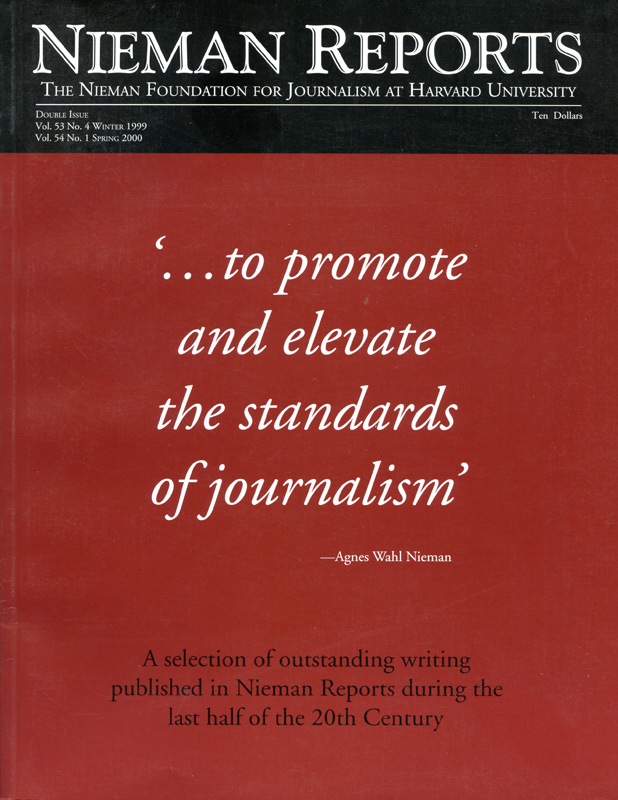From the 1940’s through the 1990’s, technological innovation in electronic media has tugged print journalism into unaccustomed realms of news reporting. During earlier decades, this tug came most strongly from television. Today it arises out of the proliferation of cable stations and the explosive growth of the Internet. Throughout this time, commentary about the evolving impact on journalism has appeared in Nieman Reports.
“The challenge of television to the newspaper is one which newspapermen cannot take lightly,” John S. Hayes, then President of The Washington Post’s radio station, advised the American Society of Newspaper Editors in the fall of 1951. “If you do not consider carefully what you can do better than radio or television…you will find yourselves in a losing battle for time, and you will find the public will drift from you to the other media.”
By the following year, cartoonist Al Capp accused television of going the way of radio and airing editorial views “bought” by advertisers, something he argued would never occur in “any great American newspaper.”
And by the mid-1960’s, Richard L. Strout, Washington correspondent for The Christian Science Monitor, suggested that radio and television be barred from live presidential press conferences. “The effect [of their presence] at White House press conferences is to make us all reluctant, unpaid, Hollywood actors, ending all intimacy, and encouraging the exhibitionists,” he wrote. “As every reporter knows, it is not the first question in a group interview that gets the answer, it is the second or third follow-up question. But with TV the question is asked, it is answered or evaded, and that’s that. The reporter has had it.”
CBS Producer Fred Friendly reminded Nieman Fellows in a 1981 seminar that “you can’t do the news in 22 minutes. The tragedy is that people think they are getting the news. So they say, ‘Well, I don’t have to read a newspaper, certainly not an afternoon newspaper. I heard all the news; that man said, ‘That’s the way it is,’ so that must be the way it is. But that isn’t the way it is; it’s a bunch of very good reporters running around Washington with cameras.”
What was referred to as “the interactive, multi-media world” in the early 1990’s would in a few years be known widely as the Internet. In 1994, Katherine Fulton (NF’93) offered a prescient glimpse into that future when she wrote, “…newspaper publishers….[are] taking old forms and formats and retrofitting them for use on line, trying to adapt the strengths of an old medium to a new medium no one yet understands. As anyone who has studied the media will tell you, that won’t be enough. But what will be enough? Nothing less than re-imagining what it means to be a journalist in a democratic society, with these new tools at our disposal.”
“The challenge of television to the newspaper is one which newspapermen cannot take lightly,” John S. Hayes, then President of The Washington Post’s radio station, advised the American Society of Newspaper Editors in the fall of 1951. “If you do not consider carefully what you can do better than radio or television…you will find yourselves in a losing battle for time, and you will find the public will drift from you to the other media.”
By the following year, cartoonist Al Capp accused television of going the way of radio and airing editorial views “bought” by advertisers, something he argued would never occur in “any great American newspaper.”
And by the mid-1960’s, Richard L. Strout, Washington correspondent for The Christian Science Monitor, suggested that radio and television be barred from live presidential press conferences. “The effect [of their presence] at White House press conferences is to make us all reluctant, unpaid, Hollywood actors, ending all intimacy, and encouraging the exhibitionists,” he wrote. “As every reporter knows, it is not the first question in a group interview that gets the answer, it is the second or third follow-up question. But with TV the question is asked, it is answered or evaded, and that’s that. The reporter has had it.”
CBS Producer Fred Friendly reminded Nieman Fellows in a 1981 seminar that “you can’t do the news in 22 minutes. The tragedy is that people think they are getting the news. So they say, ‘Well, I don’t have to read a newspaper, certainly not an afternoon newspaper. I heard all the news; that man said, ‘That’s the way it is,’ so that must be the way it is. But that isn’t the way it is; it’s a bunch of very good reporters running around Washington with cameras.”
What was referred to as “the interactive, multi-media world” in the early 1990’s would in a few years be known widely as the Internet. In 1994, Katherine Fulton (NF’93) offered a prescient glimpse into that future when she wrote, “…newspaper publishers….[are] taking old forms and formats and retrofitting them for use on line, trying to adapt the strengths of an old medium to a new medium no one yet understands. As anyone who has studied the media will tell you, that won’t be enough. But what will be enough? Nothing less than re-imagining what it means to be a journalist in a democratic society, with these new tools at our disposal.”



